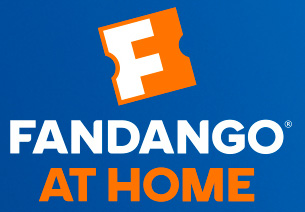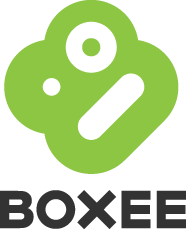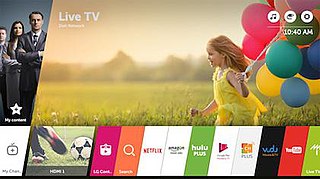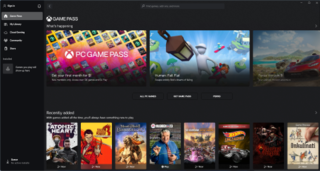In computing, cross-platform software is computer software that is designed to work in several computing platforms. Some cross-platform software requires a separate build for each platform, but some can be directly run on any platform without special preparation, being written in an interpreted language or compiled to portable bytecode for which the interpreters or run-time packages are common or standard components of all supported platforms.

Roku, Inc. is a U.S. listed company founded by Anthony Wood in 2002. It runs a streaming service through Roku-branded streaming players and smart TVs, supporting both advertising and subscription models on its platform. Roku tops U.S. streaming TV distribution, reaching households with an estimated 120 million people. Outside the U.S., the company operates in Australia, Canada, France, Germany, the U.K., and several Latin American countries including Argentina, Brazil, Chile, Colombia, Mexico and Peru.

Fandango at Home is an American digital video store and streaming service owned by Fandango Media, a joint-venture between NBCUniversal and Warner Bros. Discovery. The company offers transactional video on demand rentals and digital purchases of films, as well as integration with digital locker services for streaming digital copies of films purchased as home video at retail.
Xumo, LLC is an American internet television and consumer electronics company. It is a joint venture of Charter Communications and Comcast that operates the free ad-supported streaming television (FAST) and advertising video on demand (AVOD) service Xumo Play, and distributes Xumo Stream Box digital media players and Xumo TV smart TVs. The Xumo Play platform's service operations are based in the Greater Los Angeles suburb of Irvine, California. As of October 2020, Xumo Play has 24 million monthly active users.

Boxee was a cross-platform freeware HTPC software application with a 10-foot user interface and social networking features designed for the living-room TV. It enabled its users to view, rate and recommend content to their friends through many social network services and interactive media related features.

webOS, also known as LG webOS and previously known as Open webOS,HP webOS and Palm webOS, is a Linux kernel-based multitasking operating system for smart devices such as smart TVs that has also been used as a mobile operating system. Initially developed by Palm, Inc., HP made the platform open source, at which point it became Open webOS.
Viera Cast is a Smart TV platform by Panasonic that makes it possible to stream multimedia content from the Internet directly into select Viera HDTVs and Blu-ray players. It was announced during the January 2008 exhibition of the Consumer Electronics Show (CES) in Las Vegas and began rolling out in Panasonic Viera TVs several months later.

Google TV was a smart TV operating system from Google co-developed by Intel, Sony and Logitech. It launched in October 2010 with official devices initially made by Sony and Logitech. Google TV integrated the Android 3.0/3.2 operating system and the Google Chrome web browser to create an interactive television overlay on top of existing online video sites to add a 10-foot user interface, for a smart TV experience.

A smart TV, also known as a connected TV (CTV), is a traditional television set with integrated Internet and interactive Web 2.0 features that allow users to stream music and videos, browse the internet, and view photos. Smart TVs are a technological convergence of computers, televisions, and digital media players. Besides the traditional functions of television sets provided through traditional broadcasting media, these devices can provide access to over-the-top media services such as streaming television and internet radio, along with home networking access.

Marmalade SDK was a cross-platform software development kit and game engine from Marmalade Technologies Limited that contains library files, samples, documentation and tools required to develop, test and deploy applications for mobile devices.

Yahoo! Smart TV was a Smart TV platform developed by Yahoo! based upon the Yahoo! Desktop Widgets (Konfabulator) platform. Yahoo! Connected TV announced on August 20, 2008, at the Intel Developer Forum in San Francisco as the Widget Channel, it integrated the Yahoo! Widgets Engine with a new television oriented user interface to enable Internet connected applications to run and display on a 10-foot user interface. The platform was slowly being abandoned by its manufacturers, and was eventually deprecated. New apps that were based on Konfabulator stopped being added effective March 30, 2018, but existing apps can still be updated and installed, and HTML5 based apps are not affected by this.

The Xbox app is an app for Windows 8, Windows 10, Windows 11, Android, iOS and Tizen. It acts as a companion app for Xbox video game consoles, providing access to Xbox network community features, remote control, as well as second screen functionality with selected games, applications, and content.

Chromecast is a line of digital media players developed by Google. The devices, designed as small dongles, can play Internet-streamed audio-visual content on a high-definition television or home audio system. The user can control playback with a mobile device or personal computer through mobile and web apps that can use the Google Cast protocol, or by issuing commands via Google Assistant; later models introduced an interactive user interface and remote control. Content can be mirrored to video models from the Google Chrome web browser on a personal computer or from the screen of some Android devices.
Google Cast is a proprietary protocol developed by Google for playing Internet-streamed audiovisual content on a compatible consumer device. The protocol is used to initiate and control playback of content on digital media players, high-definition televisions, and home audio systems using a mobile device, personal computer, or smart speaker. The protocol was first launched on July 24, 2013, to support Google's first-generation Chromecast player. The Google Cast SDK was released on February 3, 2014, allowing third parties to modify their software to support the protocol. According to Google, over 20,000 Google Cast-ready apps were available as of May 2015. Support for Google Cast has since been integrated into subsequent devices, such as the Nexus Player and other Android TV devices, as well as soundbars, speakers, and later models of the Chromecast. Consumer devices that natively support the protocol are marketed as Chromecast built-in. As of October 2017, over 55 million Chromecasts and Chromecast built-in devices have been sold.

Roku is a brand of smart TV operating systems, smart TVs, streaming devices, and smart home and audio products designed and marketed by Roku, Inc., headquartered in San Jose, California, United States. Roku's smart TV products primarily offer access to streaming media content, including streaming television, from online services.

myTuner Radio, or simply myTuner, is an Internet radio app directory/platform owned by AppGeneration – Software Technologies, Lda, a development company based in Porto, Portugal founded by Eduardo Carqueja in October 2010. myTuner Radio has over 50,000 radio stations and one million podcasts from all around the world. On June 7, 2017, AppGeneration announced that its service had over 30 million users and a database with radio stations of 200 countries. my Turner Radio platform is available for the web at mytuner-radio.com, for a suite of mobile apps: iOS, Google Play, Samsung, Huawei, Amazon, Windows Phone; for desktop devices: Web, Windows, and Mac, wearables: Apple Watch and Android Wearables, for connected devices like Apple TV, Samsung TVs, LG TVs, TV sets and set-top boxes with Android TV, Amazon Fire TV, Roku TV and Chromecast, connected cars: Apple Carplay, Android Auto, Bosch mySPIN, Jaguar & Land Rover InControl Apps, and also on home appliances and smart speakers like Alexa and Sonos.
The Apple TV app is a line of media player software programs developed by Apple Inc. for viewing television shows and films delivered by Apple to consumer electronic devices. It can stream content from the iTunes Store, the Apple TV Channels a la carte video on demand service, and the Apple TV+ original content subscription service. On iPhone, iPad, iPod Touch, Vision Pro, and Apple TV devices it can also index and access content from linked apps of other video on demand services.
Flutter is an open-source UI software development kit created by Google. It can be used to develop cross platform applications from a single codebase for the web, Fuchsia, Android, iOS, Linux, macOS, and Windows. First described in 2015, Flutter was released in May 2017. Flutter is used internally by Google in apps such as Google Pay and Google Earth as well as by other software developers including ByteDance and Alibaba.

The Netflix button is a button available on many modern remote controllers, used to directly connect to the popular streaming service Netflix. It was initially implemented in America in 2011. In 2015, the button was added to European remotes. This button sends an infrared (IR) signal to the television and opens up the Netflix app. Many popular TV companies have adopted the Netflix button, including: LG, Samsung, Sony, and Hisense. Some of the TVs have made it to a list that Netflix has dubbed the "Netflix Recommended TVs". These are TVs that have a Netflix button on them which Netflix recommends to their subscribers to get the best viewing experience for their service. Some low-end laptop computers in emerging markets also ship with streaming buttons, typically including Netflix. Brazilian OEM Positivo has been including Netflix keys on their laptops since 2018.

The Roku OS is an operating system, by Roku Inc., which powers consumer electronics such as smart TVs and streaming devices. Based on Linux, it features a user interface to access Roku's Channel Store. In 2022, the Roku OS reportedly had 70 million users, and led the U.S. smart TV and streaming device sector.















